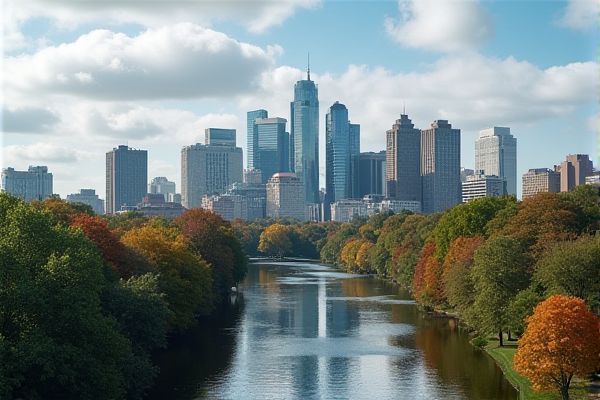
Transportation and commuting in Maryland: Maryland public transit: buses, MARC trains, Metro, light rail. Maryland Transit Administration (MTA) manages major transit systems. MARC Train connects Washington, D.C. and Baltimore. Baltimore Light Rail serves Baltimore region primarily. Washington Metro reaches suburban Maryland areas. Charm City Circulator: free bus service in Baltimore. Maryland toll requirements on key highways. Bike-sharing programs available in urban areas. Commuter tax credits available for public transit. Carpooling encouraged with dedicated HOV lanes.
Maryland public transit: buses, MARC trains, Metro, light rail.
The Maryland Transit Administration (MTA) operates a comprehensive public transit system in the Washington-Baltimore metropolitan area, including bus lines, the Metro Subway, Light RailLink with numerous stations, and the MARC Train commuter rail system with lines such as Penn, Camden, and Brunswick. The system also offers various payment options, including the Charm Card, and integrates with other regional transit services like WMATA Metrobus and Washington Metrorail. For more detailed information, visit the Maryland Transit Administration's website.
Maryland Transit Administration (MTA) manages major transit systems.
The Maryland Transit Administration (MTA) manages a comprehensive transit system in Maryland, operating Local Buses, Commuter Buses, Light Rail, Metro Subway, and MARC Train services, as well as a paratransit system, to provide safe, efficient, and reliable transportation across the Washington-Baltimore metropolitan area.
MARC Train connects Washington, D.C. and Baltimore.
The MARC Train connects Washington, D.C., and Baltimore through its three rail lines: the Brunswick Line, Camden Line, and Penn Line, providing vital access to these cities as well as Martinsburg, West Virginia, and the Baltimore-Washington Thurgood Marshall Airport. The Penn Line operates seven days a week, while the Camden and Brunswick Lines provide weekday service, ensuring convenient travel options for both daily commuters and leisure travelers.
Baltimore Light Rail serves Baltimore region primarily.
The Baltimore Light RailLink, operated by the Maryland Transit Administration (MTA), serves the Baltimore region, connecting downtown Baltimore to its northern and southern suburbs, including destinations like Timonium, Hunt Valley, BWI Marshall Airport, and Glen Burnie. With a main north-south line and several branches, it facilitates commuter travel and access to various key locations. For more detailed information about this transportation system, visit their comprehensive page on the Baltimore Light RailLink.
Washington Metro reaches suburban Maryland areas.
The Washington Metro, also known as Metrorail, serves the Washington metropolitan area, including several jurisdictions in Maryland, such as Montgomery and Prince George's Counties, providing convenient commuting options through its six lines and 98 stations. It connects suburban areas to downtown Washington, D.C., enhancing regional mobility and accessibility. For further details on its operations, network, and history, visit the Washington Metro page on Wikipedia.
Charm City Circulator: free bus service in Baltimore.
The Charm City Circulator is a free bus service in Baltimore, operating on five routes—Green, Purple, Orange, Banner, and the new Cherry Route starting June 23, 2024. With frequencies ranging from 10 to 40 minutes, it connects various downtown neighborhoods and attractions. This service provides a convenient, reliable, and eco-friendly form of public transportation. For more information, visit the Charm City Circulator website to explore the vibrant routes that this service offers throughout the city.
Maryland toll requirements on key highways.
In Maryland, tolls on key highways such as the Baltimore Harbor Tunnel, Fort McHenry Tunnel, Francis Scott Key Bridge, and the John F. Kennedy Memorial Highway can be paid using E-ZPass, Pay-By-Plate, or Video Tolling. Rates vary by vehicle classification and payment method, with E-ZPass Maryland offering cheaper rates compared to out-of-state E-ZPass and video tolling.
Bike-sharing programs available in urban areas.
In Maryland, particularly in urban areas like Baltimore and the Washington, D.C. suburbs, bike-sharing programs such as Capital Bikeshare and dockless programs operated by vendors like Veo, Lime, and Bird are available. These programs, supported by the Maryland Department of Transportation, offer both docked and dockless options, with a focus on safety, accessibility, and integration with existing transportation infrastructure.
Commuter tax credits available for public transit.
Maryland-based businesses have the opportunity to benefit from a 50% tax credit, reaching up to $100 per month per employee, for covering eligible commuter expenses. These expenses encompass a wide range of options, including Metrorail, Metrobus, MARC, and Ride On transit passes. Additionally, businesses can include vanpools, cash instead of parking, telework subsidies, carpool subsidies, active transportation programs, and multimodal last-mile connections as part of the eligible expenses. This substantial credit can be applied against the State Income Tax, the Financial Institution Tax, or the Insurance Premium Tax, making it a valuable incentive for supporting sustainable commuting options. For more detailed information, businesses can visit the Bethesda Transit website.
Carpooling encouraged with dedicated HOV lanes.
In Maryland, carpooling is encouraged through dedicated High Occupancy Vehicle (HOV) lanes, which require at least two people in the vehicle to use them, providing faster travel times and reducing traffic congestion. Additionally, plug-in electric vehicles can also use HOV lanes with a special permit, regardless of the number of occupants, as part of the state's incentives to promote eco-friendly transportation.
